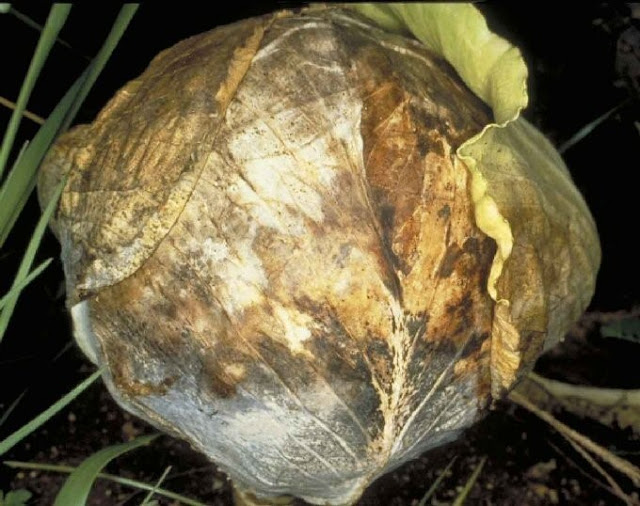Cabbage is vulnerable to several pests and diseases. All can be controlled to a greater or lesser extent, but in some cases the only solution is to plant a resistant variety.
1. Cabbage
worms, Cabbage loopers
Affected Area: Leaf
Description: Loopers are
caterpillars that are generally green or greyish, taking on the colour of the
host plant. They may blend well and be difficult to see. They eventually
develop into white- or yellow-winged butterflies often seen fluttering about
the plants. Caterpillars feed on the underside of leaves leaving ragged holes
sometimes to the extent that plants starve and die.
Control: Spray with
Bacillus thuringiensis (Bt) Comercially available as Dipel or Thuricide.)
2. Cutworms
Affected Area: Stem
Description: Plants chewed
off just above ground level. Cutworms are caterpillars 1 1/2″ long and mottled
or striped green, brown or grey. When they are disturbed, they roll up in a
coil. They usually position themselves at the moisture line in the soil moving
up and down according to the water content. If the soil surface is dry, they
will be found a couple of inches below the surface where the moisture begins.
When newly watered, they will be at the surface.
Control: Put cardboard
collar around new transplants to extend 1″ to 2″ above and below soil level.
3. Root maggots
Affected Area: Root
Description: Leaves wilt
and growth is stunted. Insect is common, white, root feeding maggot. 1/4″ long
adult flies emerge from the soil about the time cherries bloom and lay eggs at
base of plants in surrounding soil. Legless larvae feeds on host plant for
three weeks, riddling the roots with brown tunnels before they pupate Two or
three generations can occur each growing season.
Control: Use Diazinon
before planting as a soil treatment. Rotate from year to year.
4. Flea beetle
Affected Area: Leaf and Root
Description: Tiny holes,
pinholes, chewed in leaves by adult insect. Adult insects are 1/16″ long, hard
shelled, shiny, dark-coloured beetles that jump when disturbed. Slender,
whitish, cylindrical larvae feed in or on roots but root damage is generally
minimal.
Control: Dust with
Rotenone. Keep debris removed. Rotate location of planting from year to year.
5. Aphids
Affected Area: Leaf
Description: Green, red
black or white insects that cause curled yellow leaves and exude a honeydew
substance.
Control: Insecticidal
soaps or a strong stream of water or most labelled insecticides like Diazinon
or Sevin. A layer of aluminum foil under plants reflects light to underside of
leaves making them an undesirable habitat for aphids.
6. Diamondback
moth caterpillar
Affected Area: Leaf
Description: This
caterpillar causes small holes in the leaves and weaves cocoons about 1/3 inch
long on the leaves.
Control: The best form
of control is to apply an effective insecticide.
7. Damping off
Affected Area: Seedling
Description: Young
seedlings wilt and die.
Control: Use treated
seed and let soil dry out between waterings.
Affected Area: Leaf
Description: Leaves turn
yellow (chlorotic) beginning at margins and spreading inwards. Veins within
area turn black. Infection enters main stem turning the inside black. Plants
either die or are dwarfed when young, become defoliated if more mature.
Control: Plant
resistant varieties and rotate crops from year to year.
9. Black rot
Affected Area: Leaf
Description: Humid rainy
conditions are ideal for the development of black rot. Yellow to light brown
patches appear at the margins of leaves and later black veins develop within
the yellowed areas. Affected areas turn brown and dry out, often leaving a
triangular-shaped lesion on the leaf margin with one point of the triangle
directed toward the midrib.
Control: The best form
of control is to avoid sprinkler irrigation and plant tested seed.
10. Alternaria leaf
spot
Affected Area: Leaf
Description: During wet
seasons, a brown velvety spore-bearing lesion appears on the older leaves. Leaf
spots begin as a small dark spot and enlarge to form a large circular lesion
forming a bull’s-eye pattern.
Control: The best form
of control is to apply fungicides.
This is where
we will be ending our discussion for today. Remember to share your comments, views and opinions.



.jpg)





Comments
Post a Comment